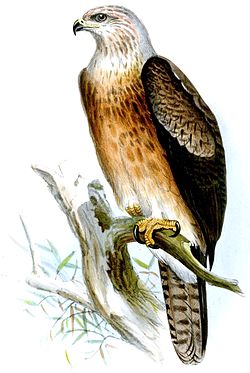| Gurney's eagle | |
|---|---|
 | |
| Scientific classification | |
| Kingdom: | Animalia |
| Phylum: | Chordata |
| Class: | Aves |
| Order: | Accipitriformes |
| Family: | Accipitridae |
| Genus: | Aquila |
| Species: | A. gurneyi |
| Binomial name | |
| Aquila gurneyi Gray, GR, 1861 | |
Gurney's eagle (Aquila gurneyi) is a large eagle in the family Accipitridae. It is found in New Guinea and Wallacea, and is an occasional vagrant to Australia.
Contents
The common name and Latin binomial commemorate the British banker and amateur ornithologist John Henry Gurney (1819–1890). [2]


